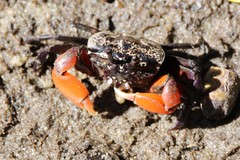This crab named after their behaviour of waving their twisted claws in the air to communicate with other crabs. The only species in this genus and family they are identified by their shape being wide across the carapace and narrow in length, the carapace is a mottled dark colour whilst their claws vary with age and sex. The juvenile crabs having a greenish claw that changes to orange and pink and finally mature males with purple claws.
The crabs emerge from their burrows during low tide to feed detritus in the sediment of the mud flats and river banks where they live often swarming in numbers over the mud only to disappear when they sense nearby movement or disturbances.
You can help suppport me bringing this information to you via my Paypal
What habitats does Heloecius cordiformis live in?
In burrows on intertidal mudflats and swamp areas
What is the distribution of Heloecius cordiformis?
Along the east coast of Australia including around Tasmania
How big does Heloecius cordiformis grow?
Can grow up to around 3cm
You can support me by dropping some funds into my Paypal account
Disclaimer: A lot of work goes into trying to identify and ensure accurate identifications are made and that the listed Descriptions, Sizes, Habitats and Distribution information is as accurate and valid as possible. Unfortunately, information in this arena is ever changing and as such no guarantee can be offered that it is correct or currently valid as a result the information is provided as a guide, and it is always suggested that you do a little research to ensure you have the latest and most accurate information. View the reference's or bibliography I welcome any feedback and comments on the information provided.








